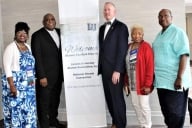You have /5 articles left.
Sign up for a free account or log in.

Librarians are struggling to ensure archives are both diverse and represent the digital records of events.
Getty Images
Hundreds of students protesting the Israel-Palestine conflict at Princeton University last month made for an event to remember, but detailing how it happened—and preserving that memory for historical archives—has proven more difficult than slipping demonstration fliers into dusty folders for posterity.
“What were they using? Instagram,” said Daniel Linke, university archivist and deputy head of special collections at Princeton University Libraries. “How to save those things is much harder to answer.”
Archiving digital content—ranging from emails and social media posts to text messages—is something Linke had hoped to avoid by retiring early. “But I was born just a bit too late,” he said. “This will be the challenge for the profession.”
The need to streamline digital archiving has been a creeping concern for university librarians for years. It’s a task made even more daunting by the need to ensure diversity and equity and the ongoing discovery of gaps in archives that leave many stories untold.
“We’re really having to stop our denial,” said Nadia Ghasedi, associate university librarian for the special collections, preservation, and digital strategies division at Washington University.
“There’s been years where a collection has come in a paper form and some hard drives,” she said. “We process the paper because that’s what we're comfortable with and the other stuff sits there, where, ‘It’s a problem for tomorrow.’ And tomorrow is here.”
Diversity Gaps in Archiving
Librarians acknowledge there has been a history of excluding underrepresented groups from archiving, either intentionally or due to systemic bias.
Linke said that when he arrived at Princeton as an assistant archivist three decades ago, he reviewed the 200 collections—and found only four directly related to women.
Many librarians have attempted to address exclusion, with more concerted efforts after the calls to action in June 2020 that followed the murder of George Floyd.
That year, Carnegie Mellon University initially wanted to have its annual fall exhibit focused on the histories of campus diversity, but archivists realized they did not have enough material. According to a 2019 survey, out of CMU’s 90 collections of work, 22 percent represented women and people of color—and just four of those were available to researchers.
“We were confronted with the challenge of developing an exhibit focusing on diversity at CMU while using an archive that can best be described as very white and male,” the university’s library said in an opening for its exhibit What We Don’t Have: Confronting the Absence of Diversity in the University Archives.
The university ended up highlighting six gaps they came across while archiving, including lack of information about CMU’s Black Student Advisory Committee and the history of the university’s annual Lunar Gala to celebrate the Chinese New Year.
Gaps in university archives are not uncommon. At North Carolina State University, Virginia Ferris highlights holes in the university’s own collection as a way to show students the importance of archiving.
“We’re showing students, ‘Here’s the history in our community on campus,’ and inviting them to think about whose voices are here and whose are not, what the silence tells us and why those records didn’t make it,” said Ferris, the lead librarian for outreach and engagement in the Special Collections Research Center.
She pointed toward the example of Justina Williams, the first Black staff member in the genetics department at the university. While there is a photo of her working in a lab, little else is known about her despite her 50 years at NCSU.
“I don’t think an alum 30 years from now will call and say, ‘I still have my Tumblr account.’ It’s a race against time to collect the records before they disappear.”
Daniel Linke, deputy head of special collections at Princeton University Libraries
Ensuring Equity in Archiving
“Librarians have been very active since the beginning of the internet, developing preservation standards for materials and how to migrate them to keep their fidelity,” said Judy Ruttenberg, senior director of scholarship and policy at the Association of Research Libraries. “With respect to [ensuring] diversity, that’s also the job of librarians—to serve the entire community.”
But how exactly to do the work is still up for debate.
The American Library Association’s Bill of Rights says materials “should not be excluded because of the origin, background, or views of those contributing to their creation.” The Association of Research Libraries hosts a diversity and equity-focused conference annually, and offers documents encouraging university libraries to ensure underrepresented groups are represented.
But there is no catch-all document detailing how that can be done.
“We’re all learning together,” Ghasedi said. “In many ways, it feels a little like uncharted territory even though there’s been great work done around this.”
There also are efforts to educate students on the importance of archiving. While the majority of university students grew up in a digital-first world, many do not know how to deploy solid digital practices.
“With digital natives, you’d think this is second nature but there are a lot of things most people don’t think about and why would they?” Ghasedi said.
In the interim, librarians scramble to archive what is there.
“I don’t think an alum 30 years from now will call and say, ‘I still have my Tumblr account,’” Linke said. “It’s a race against time to collect the records before they disappear."
Archiving in Action
One of the top ways universities are boosting archival diversity is utilizing community outreach practices, including talking to student groups, student leaders and community organizations.
Princeton has its Archives Research and Collaborative History Program (ARCH), which has helped roughly 60 students from historically black colleges and universities learn about archiving programs in an effort to diversify the archivists themselves.
“It’s not fine if you post a job saying, ‘Everyone is welcome to apply,’ but no people of color apply because they don’t know about archiving,” Linke said. “[ARCH is] showing undergraduates that what we choose makes history. And we don’t have to explain to people of color how they haven’t been included and how having them included enhances the conversation.”
Washington University received a grant in 2021 from the Mellon Foundation to expand, preserve and use “born-digital” poetry collections, or those written on computers, for example, instead of on paper. One of the incentives is diversifying the types of poets in the archives. But doing so requires a one-two punch of gaining trust from the community and then collecting that work.
Ghasedi said that, initially, they easily found students through higher education institutions, but many poets do not have an affiliation to an institution, “so we worked harder to find folks locally.”
“An underlying driver for everything we do has to do with this long-standing problem within our institutions of having predominantly white collecting practices,” Ghasedi said. “And not really being proactive in ensuring there’s equity and representation.”
Public outreach takes time, money and effort—which university libraries often do not have to spare. Ferris, who works as a public outreach coordinator, suggested if there are not enough resources to hire someone, other simple tactics can be taken, with both active and passive engagement.
Exhibits or signs can be hung up across campus, Ferris said, suggesting a QR code that invites students to submit their own materials for archiving.
“Showing letters from students or fliers from events they were doing 100 years ago—when they see they’re reflected in the record it sinks in,” she said. “It’s, ‘The stuff I’m sending out this week looks like correspondence from 1968. And a student could look 50 years from now and see what I sent.’”
The work will continue to evolve with the emergence of new tactics and technologies, the latest being artificial intelligence.
“There’s provenance issues with authentication, transparency, knowing what it is and understanding where a document came from,” ARL’s Ruttenberg said. “Every evolving technology reintroduces that challenge.”









